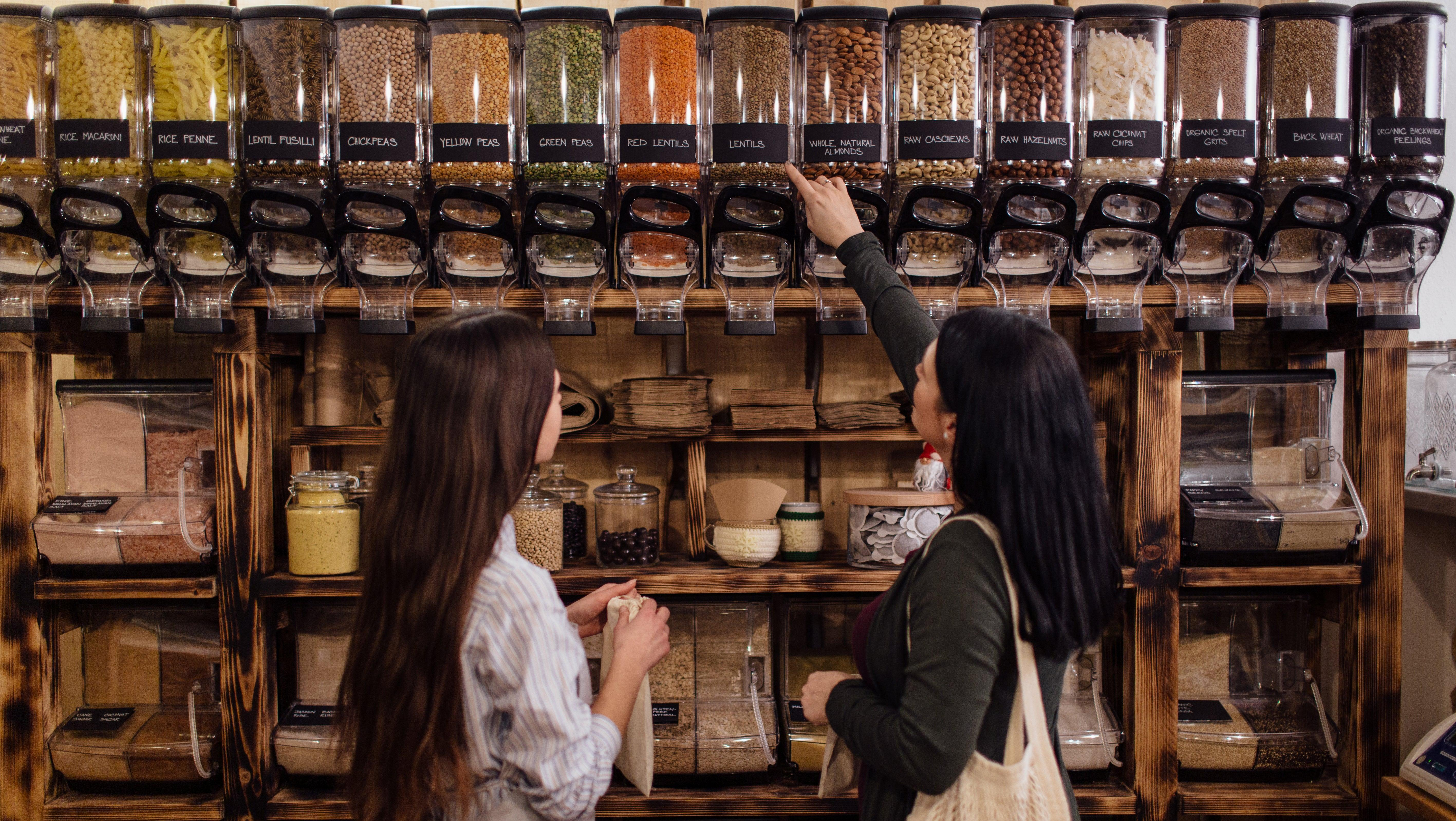A Guide To Zero-Waste Grocery Shopping
Everything you need to know to dive into a more sustainable lifestyle.
Sorry to be a bummer, but the climate crisis is only getting worse and worse. And food packaging and containers are a huge part of the problem, generating more than 82 million tons of waste each year, according to the EPA. But we're lucky to live in a world full of innovation and ways to help even a little bit. Instead of letting this stat get you down, use it as motivation to dive into the world of zero-waste grocery stores.
What are zero-waste grocery stores?
Sustainable markets focus on eliminating all packaging. Customers bring in their own jars, reusable bags, or Tupperware containers and use those to package everything from dried goods to produce to cleaning products. And it's not just about allowing customers to go zero-waste in their shopping; it also keeps the waste of the store itself at zero.
"We took a ton of time before even placing orders to stock our shelves to make sure that either the program was a closed loop so we could ship things back to the manufacturer and they can fill them up again and keep reusing them or that things would coming in recyclable, reusable, and upcycled packaging," says Jackie MacCartie, co-owner of Chicago-based zero-waste general store Eco & the Flamingo. "We compost, we recycle everything we can, we have separate piles for plastic that we don't know what to do with. We're taking time to make sure that as a business we're creating less of an impact as well."
While the model is still gaining momentum in the United States, the success of zero-waste stores overseas proves promising—especially as it relates to big brands. Aldi, which is based in Germany, has committed to making all food packaging reusable, recyclable, or compostable by 2025. But until all the major brands catch up, smaller markets like Eco & the Flamingo are the best places to jumpstart sustainable shopping habits.
How to start a zero-waste lifestyle
"The first step is just to take a look around at the things that you have and you use and just do a little inventory," MacCartie says. "How much of this is stuff that I actually use, how much of this comes in a container that can be replaced with something that is more sustainable, and how many of these things are in single-use plastic that I could be eliminating all together?"
Just taking stock of your own personal inventory is a great place to start, but don't let it overwhelm you. From there it's about just doing one small thing at a time. And even if you're not able to make it to a speciality market, there are steps you can take. "The next time you go to the grocery store, try your best to opt out of as much plastic as you can," MacCartie says. "Instead of buying your produce in pre-packed packaging, buy one head of lettuce. And when you're done, chop the bottom off, stick it in some water, and grow more lettuce."
If you do have access to a zero-waste shop, try popping in just to browse and ask questions. One of the advantages of these brick and mortar markets is access to not only employees, but also other customers who can offer tips and tricks. For example, my friend Sue Kwong who frequents zero-waste markets in Toronto recommended weighing out all your containers before heading to the store—it'll make for a quicker checkout. Tips like that are a great place to start.
And when it comes to reusable containers, most places allow you to bring in anything you want. Don't be scared to use this opportunity to give new life to any non-recyclable takeout containers. "People get shy about bringing in plastic containers—bring in those plastic containers, keep those things out of a landfill!" MacCartie says.
The biggest hurdles to zero-waste living
As with anything new, there are some road bumps, mostly involved with educating customers. MacCartie says the price difference is something that often gives people pause, but once she's able to explain to them why things might be a little more expensive in a zero-waste store, it becomes more understandable.
"Not only are we sourcing these ingredients from a sustainable company, they're a small company too, but these are aquatic-safe ingredients—when they go into the water they're going to be safe for us to drink later," MacCartie says. "The price points are different and it's because of the quality. It's not because we're just trying to price gouge you; it's because the quality of the ingredients we're supplying are supreme, because the people that we are paying are being paid in full all the way down the supply chain. That costs money."
And because this is not yet a wide-spread model, it's hard for business owners to stay fully zero-waste when owning and operating one of these stories. That just means that every other bit of sustainability needs to be on point.
Other ways to be make your groceries more sustainable
There are small adjustments you can make to your home routine to keep things zero waste as well. One of the best things for food waste is to start composting—and there are a variety of vessels for all lifestyles and housing arrangements to make it just that much easier.
As for things you can't recycle or compost, have you considered a craft? "Garbage is our most free and accessible art medium," MacCartie says.
But the best thing you can do when diving into sustainability is not be too hard on yourself. You don't have to dive in headfirst—slow and steady is the key. "You don't have to go from 60 to zero, just go from 60 to 50 first, just pump the brakes," MacCartie says. "Make little changes first."
